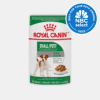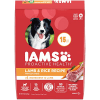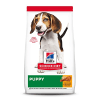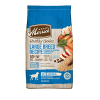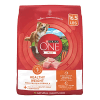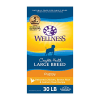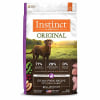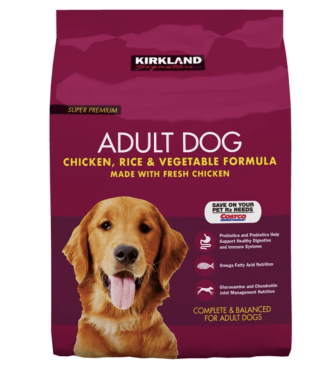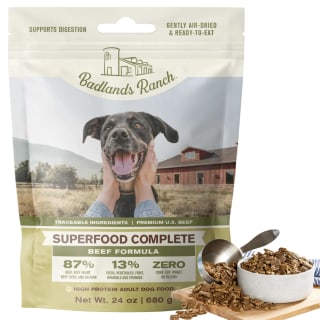When deciding between wet and dry dog food, you and your pup’s personal preferences play a big role. Both dry and wet food can be good nutritional choices for your dog, but each comes with pros and cons, says Dr. Dottie Laflamme, an independent animal nutrition consultant. The best dry dog food is convenient, cost effective and can even be good for your dog’s oral health. Keep in mind that canned food holds significantly more moisture than dry food, so consult your veterinarian if your dog has any conditions that might benefit from a moisture-rich diet.
While ingredient lists are informative, the quality of your dog’s kibble is primarily determined by four factors, according to Laflamme: palatability, a complete and balanced recipe, affordability and whether the food meets your veterinarian’s approval based on your dog’s nutritional needs.
To help narrow down the best dry dog foods, I spoke with veterinarians about identifying a complete and balanced recipe for your dog’s diet. I also rounded up their recommendations for the best dry dog food.
SKIP AHEAD How I picked the best dry dog food | Best dry dog food to consider this year | How to shop for the best dry dog food | Why trust NBC Select?
How I picked the best dry dog food
With so many dry dog food options on the market, I spoke to experts who recommended keeping the following factors in mind:
- Breed size: To ensure your dog gets the nutrients they need, it’s important to purchase the appropriate food for their life stage and breed size, which can be categorized into three stages: growth, all life stages and adult maintenance.
- AAFCO statement: If your dog’s dry food is labeled with a statement saying it meets the Association of Animal Feed Control Officials (AAFCO) recommendations through formulation or food-trial testing, it means that it contains all the necessary nutrients for your dog’s life stage and ensures a complete and balanced diet, says Dr. Anna Kaufman, a veterinarian at Bond Vet, which has locations across the United States.
- Nutritional guidance: A recipe created with the guidance of a board-certified veterinary nutritionist is more likely to provide the appropriate nutrients for your dog’s age and breed size rather than relying on marketing tactics. Key ingredients to look for include an animal protein source, whole grains or high-quality carbohydrates, fruits and vegetables and healthy fats, says Dr. Nicole Savageau, a veterinarian with The Vets, a mobile vet service.
- Price: “Dry dog food tends to be more cost-effective compared to wet dog food, primarily due to factors such as production costs, packaging, and shelf life,” says Savageau. If budget is a concern, dry dog food can be a more economical choice.” Given this, we considered a range of quality options at various price points.
Want more from NBC Select? Sign up for our newsletter, The Selection, and shop smarter.
Best dry dog food of 2025
The following highly rated dry food share two important considerations: They meet or exceed the nutritional recommendations set by AAFCO and are formulated with the oversight of a board-certified veterinary nutritionist. These factors ensure that your dog is getting the right nutrients for their age and breed size. However, you should always check with your dog’s veterinarian first about your dog’s specific dietary needs in conjunction with age to get an expert read on any dietary needs or restrictions.
Best budget-friendly: IAMS Adult Minichunks
- Diverse recipes
- Promotes healthy digestion
- Suitable for sensitive stomachs
- Not for giant breeds
When it comes to kibble, there is often a wide range of options available to pet parents at varying price points. For those on a budget, certain dry dog foods may include byproducts that help keep the cost down. “Byproducts are ingredients that are not typically used for human consumption,” says Dr. Jonathan Stockman, assistant professor of clinical veterinary sciences at Long Island University College of Veterinary Medicine. It’s not because the ingredients aren’t nutritious, but it might include meat that isn’t visually appealing or internal organs that aren’t culturally accepted as a food source. Byproducts are a great source of vitamins and minerals for dogs, and from a sustainability standpoint, using byproducts also helps to reduce food waste, says Stockman.
IAMS’ recipe offerings are diverse, and IAMS Adult Minichunks is a standout choice due to its high-quality protein sources, such as lamb, chicken and whole-grain barley. The recipe also contains a blend of fibers and prebiotics to promote a healthy digestive system, according to the brand.
Best for adult small breeds: Royal Canin Small Breed Adult Dry Dog Food
- Crunchy texture
- Multiple kibble sizes
- Resealable bag
- Nothing to note at this time
Royal Canin is a favorite dog food brand among the veterinarians I spoke to for its peer-reviewed research and well-regarded reputation among pet parents and veterinarians. NBC Select updates editor Mili Godio is a fan of Royal Canin, too: Godio has been feeding her 6-year-old havanese and bichon frise mix, Bella, this dry food since she was just a few months old. Royal Canin increases palatability by sourcing ingredients that dogs crave, like chicken and chicken fat, according to the brand.
Best for small-breed puppies: Hill’s Science Diet Puppy
- Smaller kibble size
- Helps with brain development
- Nothing to note at this time
Puppies require more calories per pound of body weight than adult dogs to fuel their growth and active lifestyles. AAFCO recommends that puppy food include 22% protein and 8% fat, and other important vitamins and nutrients for growth.
According to both Laflamme and Kaufman, Hill’s is a trustworthy brand that delivers quality pet food to pet parents and their pups, and Hill’s Science Diet’s dry dog food for puppies is no exception. It’s packed with the nutrients your puppy needs for a healthy start to life, like calcium and phosphorus to help build strong bones and teeth, and the omega fatty acid docosahexaenoic acid (DHA) to support healthy brain and eye development. The formula contains antioxidants and vitamins E and C to support your puppy’s developing immune system, according to the brand.
Best for large-breed puppies: Wellness Complete Large Breed Puppy
- Supports healthy hips/joints
- No artificial preservatives
- Supports immune system
- Not for smaller breeds
When allowed to overeat, large-breed puppies tend to grow too quickly, and their bones might not be able to keep up, says Laflamme. This puts them at risk of developing orthopedic or skeletal issues. “One of the best ways to prevent this is by keeping your puppy lean, limiting the amount of food they’re allowed to have and feeding them a diet specifically formulated for growing large breed puppies,” she says.
Large-breed formulas that meet AAFCO’s nutritional adequacy recommendations have all the protein and minerals your puppy needs, but with fewer calories. This Wellness formula has just 367 calories per cup, which includes protein from deboned chicken and chicken meal, as well as energy-rich carbohydrates like brown rice and oats, according to the brand. The formula also has glucosamine, which helps maintain joint health and is particularly beneficial for large-breed dogs, according to Wellness.
Best for adult large breeds: Merrick Healthy Grains Large Breed
- Supports healthy hips/joints
- Large kibble size
- For adult dogs only
Most large-breed dogs are no longer considered puppies when they reach about two years of age. However, this can vary depending on the individual dog and when they stop growing. During this period, Laflamme recommends two options for transitioning your dog to a formula suitable for adult dogs: either switch to an all life stages food that provides nutrients for both puppies and adults, or consider an adult formula that’s not suitable for a growing puppy.
This adult formula from Merrick is made in small batches in Merrick’s Hereford, Texas kitchen. It’s packed with omega-6 and omega-3 fatty acids, which means it’s specially formulated with glucosamine and chondroitin to support healthy hips and joints, according to the brand. It also contains L-Carnitine, a supplement that helps to keep your gentle giant lean, according to Merrick.
Best for sensitive stomachs: Instinct Original Grain-Free Recipe with Real Rabbit
- Diverse protein
- Helps digestion
- Great for healthy coat
- Grain-free formula
Many pet food diets are touted as grain-free, meaning they don’t contain common carbohydrate grains, like wheat, rice and barley. But unless your pup has a gluten intolerance, grain-free diets aren’t known to provide additional benefits when compared to other complete and balanced foods, according to our experts. Unlike their gray wolf ancestors, there’s evidence that domestic dogs are perfectly able to digest carbohydrates, says Stockman.
A novel protein or limited-ingredient diet may relieve your dog’s symptoms if they have a food intolerance or a true food allergy. This option from Instinct uses rabbit as its protein source and leaves out any ingredients that include corn, wheat and soy, according to the brand. Additionally, probiotics and omega-3 and -6 fatty acids soothe the digestive tract, skin and any lingering inflammation.
Best for digestive and joint health: Kirkland Signature Adult Formula Chicken, Rice and Vegetable Dog Food
- Good source of protein
- Budget-friendly
- Also in small dog formula
- No bag size variety
“One of the only things my 8-year-old pitbull loves eating that doesn’t upset her stomach is this dog food,” says NBC Select associate reporter Bianca Alvarez, who has been feeding this to her dog for years. “It’s great because she loves it, and it’s such a big bag that you get your money’s worth.”
This formula includes multiple ingredients, including protein (to support their muscles), antioxidants (to promote a healthy lifestyle), fatty acids (to maintain their coat and immune system), probiotics (for digestive health) and glucosamine and chondroitin (to help support healthy joints), according to the brand. “As Baylor gets older, it’s a big priority for us to focus on feeding her food that will keep her healthy, and this one has ticked off all the boxes. Luckily, we haven’t encountered any health problems and can give a lot of credit to this formula, which has been a constant for most of her life.”
Best for weight management: Purina ONE + Plus
- Good for older dogs
- Crunchy texture
- High protein formula
- Not for young puppies
The feeding instructions on the back of the kibble bag are merely a guide — your veterinarian is the best resource for determining the appropriate number of calories your dog should eat, says Laflamme. Between veterinarian visits, you should monitor your dog’s body condition using the nine-point scale based on observation and physical touch, she says. You can do this by standing above your dog, putting your thumbs over the backbone and fingers over the ribs. Gently move your hands from front to back. If you can easily count and feel your dog’s ribs, they are likely a healthy weight.
If you and your veterinarian determine your dog is overweight, your veterinarian may suggest a reduction in calories or a weight management diet, such as this Purina ONE Weight Control formula. It’s the recipe Laflamme feeds her own dogs and is part of Purina’s budget line. However, if pet owners want to add probiotics and more natural ingredients to their dog’s diet, a slightly pricier alternative is available from Purina: Purina Pro Plan Weight Management. While it may cost a bit more, NBC Select reporter Zoe Malin says her 100-pound yellow lab, Chance, is both healthy and happy eating this formula.
Best splurge: Badlands Ranch Superfood Complete
- Available as subscription
- Supports overall health
- Also comes in beef formula
- Higher price point
- Small bag
You can use this dry food as a topper, mix it in with their standard kibble or as their whole bowl. “Baylor loves the chicken formula, but since she’s a big dog, we noticed that we were going through bags quickly, so we decided to use it as a topper to keep her meals exciting,” says Alvarez. “She’s a picky eater with a sensitive stomach but has loved every second of eating this mix, and as a dog owner, I love that it targets all aspects of her health.” The 24-ounce bag is filled with protein, fruits, vegetables and more to maintain and support your dog’s muscles, coat, immune system, vision, organs and digestion, according to the brand.
How to shop for the best dry dog food
There’s a lot to consider when buying the best food for your dog, and most come down to you and your dog’s personal preferences, as well as your dog’s life stage and breed size, according to experts.
- Ensure your dog’s food meets AAFCO standards. AAFCO is a non-profit group that establishes nutritional guidelines for pet food based on life stages. Although AAFCO doesn’t approve or regulate pet food formulas, pet food companies that include an AAFCO nutritional adequacy statement conduct thorough testing to ensure their food meets AAFCO nutritional standards for safety and quality.
- Consider your dog’s life stage. Dry dog food is typically labeled as growth, which is specifically formulated for growing puppies or all life stages, which means it meets the minimum AAFCO nutritional requirements for both puppies and adult dogs. Food for puppies must include a minimum of 22% protein and 8% fat, in addition to other important vitamins and nutrients, like DHA, calcium and phosphorus, according to our experts. Adult dogs, on the other hand, require food formulated for maintenance, or they can eat food labeled as all life stages. Maintenance dry food must include a minimum of 18% protein and 5% fat.
- Make sure it’s made for your dog’s breed size. Our experts suggested feeding according to breed size to meet the unique growth patterns and health needs of small- and large-breed puppies and adult dogs.
- Ensure the brand consults veterinary nutritionists. A recipe developed with the guidance of a board-certified veterinary nutritionist ensures the recipe has been formulated with the necessary nutrients for your dog’s age and breed size.
- Keep in mind, price doesn’t always equal quality. You should consider a range of quality options across various price points that meet AAFCO standards and are suitable for your dog’s breed, size and life stage.
Meet our experts
At NBC Select, we work with experts who have specialized knowledge and authority based on relevant training and/or experience. We also take steps to ensure all expert advice and recommendations are made independently and without undisclosed financial conflicts of interest.
- Dr. Dottie Laflamme is a veterinarian and an independent consultant of animal nutrition. She formerly worked for Purina’s Research and Development team until her retirement in 2015.
- Dr. Jonathan Stockman is a veterinarian and an assistant professor of clinical veterinary sciences at Long Island University College of Veterinary Medicine. He is also a veterinary consultant for Petco but does not receive financial compensation to recommend any brands.
- Dr. Nicole Savageau is a veterinarian with The Vets in Austin, Texas.
- Dr. Anna Kaufman is a veterinarian at Bond Vet, which has locations across the United States.
Why trust NBC Select?
I am a Portland-based freelance writer who holds a bachelor of science degree in biology. My approach to pet-care writing and reporting is rooted in scientific principles that consider a pet’s biological need for play, proper nutrition and environmental enrichment. For this piece, I interviewed experts who specialize in veterinary nutrition. I also researched dozens of dry dog foods on the market that met criteria based on our experts’ insights. I included dry dog foods recommended by experts, along with those that are highly rated and meet expert shopping guidance.
Catch up on NBC Select’s in-depth coverage of tech and tools, wellness and more, and follow us on Facebook, Instagram, Twitter and TikTok to stay up to date.

